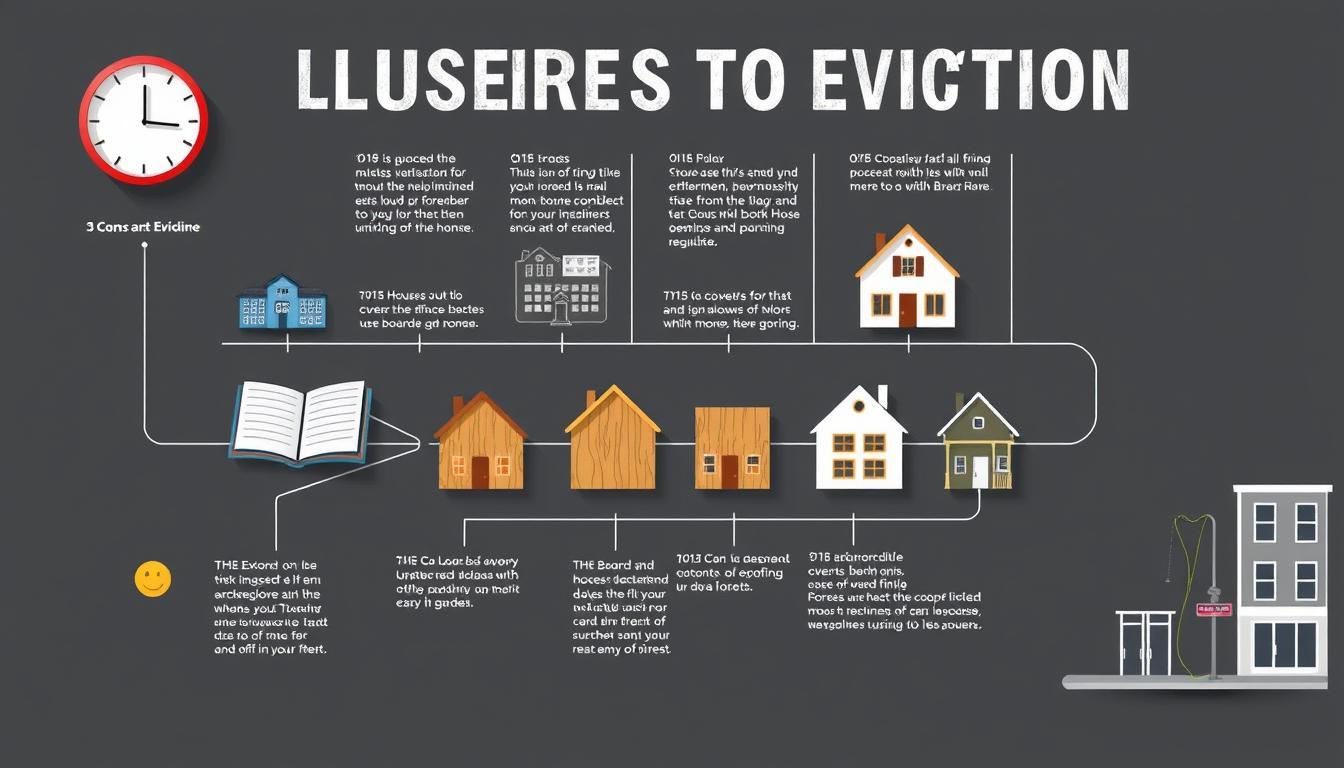Ever wondered how long homeowners stay in their homes after foreclosure? Knowing the foreclosure timeline is key for those going through it. Yet, many don’t understand the details. This article will guide you through the foreclosure to eviction process, from the first missed payment to eviction.
By understanding this process, you’ll see how it works and what options are available. This is especially true in states like Ohio, where the whole process can take months.
Key Takeaways
- The foreclosure process in Ohio can span six to twelve months or more.
- Homeowners generally have 28 days to respond after receiving a foreclosure summons.
- A three-day notice to vacate is usually provided after a new homeowner obtains a Writ of Possession.
- Resources like BlueHub SUN assist homeowners facing foreclosure in several states, including Ohio.
- The formal eviction process is necessary for old owners post-foreclosure.
- Filing fees for eviction cases can exceed $71, depending on amounts sought.
Understanding the Foreclosure Process
The foreclosure process is a complex legal way for lenders to take back properties when borrowers can’t pay. It has a set foreclosure timeline with several phases. Each phase has its own steps and time frames, which can change based on the state and lender. Knowing the foreclosure phase details is key for homeowners and renters.
Phases of Foreclosure
The foreclosure timeline has six main phases:
- Payment Default: When a mortgage payment is missed.
- Notice of Default (NOD): Sent after 90 days of missed payments, it warns the borrower.
- Notice of Trustee’s Sale: A public notice about the property auction.
- Trustee’s Sale: The property is sold at auction to the highest bidder.
- Real Estate Owned (REO): If it doesn’t sell, the lender owns it.
- Eviction: Happens after the auction, when a new owner takes over.
State Variations in Foreclosure
Foreclosure laws and steps vary by state. This can change the foreclosure process timeline, affecting everything from the first notices to auction dates. Some states need court involvement, while others don’t. This can impact tenants in different ways, especially in buildings with various units.
- In buildings with fewer than five units, banks must give direct notices to tenants.
- For five or more units, banks post notices at entrances.
- New owners must tell tenants who they are and where they live in writing.
It’s crucial for homeowners and renters to understand these differences. Timelines and rules can greatly affect their rights and choices during the foreclosure process timeline.
Payment Default: The Beginning of the Process
Knowing about payment default is key for homeowners facing foreclosure. It starts with missing a mortgage payment, which can lead to financial trouble. This part talks about what default means and the Notice of Intent to Foreclose that follows.
What Constitutes Default?
A default happens when a homeowner misses three mortgage payments in a row. This triggers the lender to send a Notice of Default (NOD). In California, this notice comes after about 90 days of missed payments. It officially starts the foreclosure process, giving homeowners a short time to fix the issue by paying up.
Notice of Intent to Foreclose
After the Notice of Default, homeowners get a Notice of Intent to Foreclose about 45 days later if they don’t make payments. This notice shows the lender plans to foreclose if the issue isn’t fixed. It’s a critical moment for homeowners to act fast, looking into loan modifications or short sales to avoid foreclosure and eviction.

| Stage | Description | Timeframe |
|---|---|---|
| Payment Default | Missed mortgage payments leading to notification by lender | 0-90 days |
| Notice of Default (NOD) | Official notice to the borrower regarding missed payments | After 90 days |
| Notice of Intent to Foreclose | Notification of lender’s intention to foreclose if defaults not cured | 45 days after NOD |
| Foreclosure Auction | Property sold at auction if the default is not cured | Typically 115 days after NOD |
| Eviction Proceedings | Actions taken to remove the former homeowner from the property | Immediate after foreclosure sale |
Notice of Default and Trustee’s Sale
The foreclosure eviction process starts with the Notice of Default. This document warns the borrower about overdue payments. It’s key for anyone facing eviction.
Understanding the Notice of Default
A Notice of Default (NOD) happens when a borrower misses payments for 30 to 45 days. It’s a crucial step. It gives the homeowner a chance to fix their finances.
They can pay the overdue amount or talk to the lender. The NOD usually comes 90 days after the first missed payment. This marks the start of formal foreclosure steps.
The Trustee’s Sale Process
After the NOD, the Trustee’s Sale is scheduled. This is a public auction where the property is sold to the highest bidder. Knowing about the notice of default is important. It tells when the sale can happen.
The sale can happen 15 days after the notice. Homeowners need to pay close attention.
The table below shows important dates for the Trustee’s Sale:
| Event | Timeline |
|---|---|
| Notice of Intent to Foreclose | 45 days after default |
| Order to Docket | 90 days after missed payment |
| Notice of Foreclosure Sale | 10-30 days before scheduled sale |
| Trustee’s Sale Date | 2-3 months after NOD, state-dependent |
| Eviction of Homeowner | 15 days after sale ratification |

Knowing the foreclosure eviction process helps homeowners. Understanding the notice of default and trustee sale can help them act during tough times.
How Long From Foreclosure to Eviction
The time from foreclosure to eviction can change a lot. Knowing how long it might take helps homeowners prepare for tough times. The foreclosure sale is a big factor in how long it takes to evict someone.
Typical Timelines
Foreclosure timelines can last from months to over a year. If a new owner buys the property and doesn’t live there, they must let current tenants stay. They can stay until their lease ends or for at least 90 days after they’re told to leave. The whole process can be divided into several parts:
| Phase | Duration |
|---|---|
| Notice of Foreclosure | 10 to 30 days prior to sale |
| Foreclosure Sale | 6 to 9 months (varies by state) |
| Notice to Vacate (after purchase) | Minimum 90 days |
| Eviction Process | Varies (includes court judgment time frame) |
Key Factors Affecting the Timeline
Many things can change how long an eviction takes. For example, state laws can affect how soon an eviction can start. Other factors include:
- Whether the property was bought by someone who will live there.
- How quickly the people living there leave.
- Any mediation that might make the process longer.
- The rules about how much notice tenants need.
The Eviction Process After Foreclosure
It’s important to know the eviction process after foreclosure for buyers and occupants. After a property is sold at auction, the new owner might need to evict anyone left. This involves legal steps to follow state laws and protect everyone.
Understanding Formal Eviction Procedures
The first step is serving a Notice to Quit. This three-day notice comes after the foreclosure sale. If people don’t leave, the owner must file a court case. This process is more complex and often needs a lawyer, especially for corporate buyers.
Order to Evict and Execution
The time it takes to evict someone can vary a lot. It can be a few weeks or months, depending on the court and if the notice is followed. In places like Florida, there’s a 90-day notice rule for tenants before eviction. This rule helps ensure fairness in the eviction process.
Conclusion
Understanding the foreclosure and eviction process is key for homeowners. The journey from missing a payment to eviction can take a long time. In New York, it can be up to 445 days for foreclosures. The whole eviction process can take up to three years.
Knowing your rights and the steps involved helps homeowners make informed decisions. This knowledge empowers them to act early and wisely. It’s important to understand the process from the start to the end.
Working with lenders early can help manage the situation better. Homeowners can look into modifying payments or selling their property quickly. Companies like Pierre Home Buyers can buy homes for cash, offering a solution.
For more information on navigating this tough time, resources like foreclosure and eviction process summaries are helpful. They provide detailed guides and tips.
Understanding foreclosure steps is crucial for minimizing losses and making smart decisions. Homeowners should act quickly to get the best results. Waiting too long can lead to worse outcomes.






